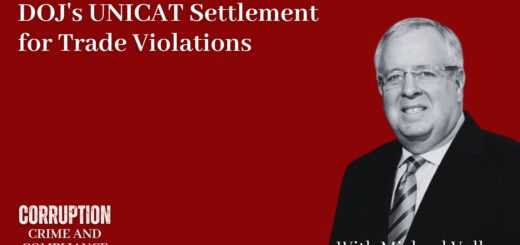Anti-Corruption and the Auto Industry
 Some industries have dodged anti-corruption industry sweeps. So far, the industry sweeps have focused on logistics, oil, pharmaceuticals and medical devices. The logistics industry has been a fertile source for other industries for obvious reasons – they deal with a variety of industries.
Some industries have dodged anti-corruption industry sweeps. So far, the industry sweeps have focused on logistics, oil, pharmaceuticals and medical devices. The logistics industry has been a fertile source for other industries for obvious reasons – they deal with a variety of industries.
The auto industry has escaped a sweep. That is likely to change. A global antitrust cartel investigation has focused on auto parts suppliers. A large number of auto suppliers are under investigation and seeking to cooperate under the Justice Department’s antitrust leniency program. Criminal antitrust investigations typically unearth corruption issues – cooperators in the auto industry are going to start naming names and companies.
Aside from this important development, the auto industry is global and has several significant bribery risks. These include:
1. Government Interactions — the auto industry is fast expanding into the BRIC countries (Brazil, Russia, India, and China), as well as Indonesia and Mexico. These countries are risky for corruption, and auto companies often have to deal with new suppliers and third party agents in these countries. The government is a key customer for government and military fleet sales. Auto sales to government and military customers is competitive and ripe for bribery violations. This intense competition raises specific bribery risks relating to gifts and donations, kickbacks, inflated invoicing, and travel and entertainment for government officials. If third party agents are used to help, this can increase the risk of such violations.
2. Government Regulations: On the regulatory front, government controls licensing, and customs which are required for international operations. Third party agents are used to navigate the local licensing and customs process. Customs clearance can be critical to auto deliveries and sales contracts. To ensure customs clearance or expedited customs clearance, auto companies may be vulnerable to bribery demands. If third party agents, or logistics companies are used, the risk can increase.
3. Joint Ventures: Auto companies are engaged in a number of joint ventures, particularly with state-owned enterprises and “private” ventures in which existing and former government officials have ownership stakes. The structure of the joint venture and the regulation of internal and external interactions is important to ensure compliance.
All of these factors combine to create significant corruption risks for auto manufacturers.
The greatest risk countries for foreign corruption in this industry are fairly obvious – China and Russia.
The auto industry in China produces the largest number of vehicles in the world. The auto industry has grown significantly over the last 20 years. Over 50 percent of all the cars produced in China are done through joint ventures with foreign car manufacturers including Volkswagen, Mitsubishi, General Motors, Hyundai, Nissan, Honda and Toyota. China’s car market is expected to grow ten fold between 2012 and 2030.
In Russia, auto production is a significant industry. Russia is the fifteenth largest auto producer in the world. Approximately one percent of Russia’s workforce is employed by auto manufacturers. Eleven foreign carmakers produce cars in Russia, several through joint ventures with Russian auto manufacturers.
Auto companies face significant risks because of the breadth and scope of their international operations. Even in those countries where they do not manufacture automobiles, companies face significant corruption risks because of relationships with government customers government regulators. These relationships create real risks for bribery.
Compliance programs in the auto industry face real challenges. A first step is an audit and risk assessment – it will take time and will expose a number of major risks. The challenge is to design and implement an effective global compliance program which is tailored to an audit and risk assessment.















